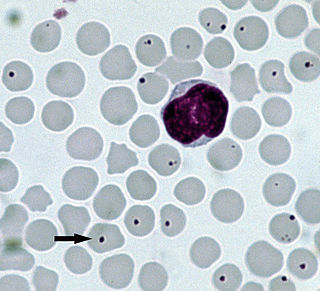
Bartonella is a genus of Gram-negative bacteria. It is the only genus in the family Bartonellaceae. Facultative intracellular parasites, Bartonella species can infect healthy people, but are considered especially important as opportunistic pathogens. Bartonella species are transmitted by vectors such as ticks, fleas, sand flies, and mosquitoes. At least eight Bartonella species or subspecies are known to infect humans.

The Ehrlichiaceae are a family of bacteria, included in the order Rickettsiales.
Bartonellosis is an infectious disease produced by bacteria of the genus Bartonella. Bartonella species cause diseases such as Carrión's disease, trench fever, cat-scratch disease, bacillary angiomatosis, peliosis hepatis, chronic bacteremia, endocarditis, chronic lymphadenopathy, and neurological disorders.
Bartonella quintana, originally known as Rochalimaea quintana, and "Rickettsia quintana", is a bacterium transmitted by the human body louse that causes trench fever. This bacterial species caused outbreaks of trench fever affecting 1 million soldiers in Europe during World War I.

Streptobacillus moniliformis is a non-motile, Gram-negative rod-shaped bacterium that is a member of the family Leptotrichiaceae. The genome of S. moniliformis is one of two completed sequences of the order Fusobacteriales. Its name comes from the Greek word streptos for "curved" or "twisted", and the Latin word bacillus meaning "small rod" and moniliformis for "necklace". S. moniliformis is microaerophilic, requiring less oxygen than is present in the atmosphere for its growth.
Bartonella alsatica is a bacterium. Like other Bartonella species, it can cause disease in animals. It is small, aerobic, oxidase-negative, and Gram-negative. Its rod-like cells were localized within wild rabbit erythrocytes when first described. The type strain is IBS 382T. It is associated with cases of lymphadenitis and endocarditis.
Bartonella bovis is a pathogenic bacteria first isolated from European ruminants. It is small, fastidious, aerobic, oxidase-negative, gram-negative and rod-shaped. Its type strain is 91-4T.
Bartonella capreoli is a pathogenic bacteria first isolated from European ruminants. It is small, fastidious, aerobic, oxidase-negative, gram-negative and rod-shaped. Its type strain is IBS 193T.
Bartonella japonica is a species of bacteria in the genus Bartonella. A strain of this species was originally isolated from the blood of a small Japanese field mouse.
Bartonella acomydis is a bacterium from the genus of Bartonella which was isolated from wild Rodentia.
Bartonella callosciuri is a bacterium from the genus Bartonella.
Bartonella coopersplainsensis is a Gram-negative, non-motile bacteria from the genus Bartonella which was isolated from the blood of a wild rat.
Bartonella jaculi is a bacterium from the genus Bartonella which was isolated from the blood of Rodentia.
Bartonella pachyuromydis is a bacterium from the genus Bartonella which was isolated from Rodentia.
Bartonella queenslandensis is a Gram-negative bacteria from the genus Bartonella which was isolated from the blood of rats from the genus of Melomys in Queensland in Australia.
Bartonella rattaustraliani is a bacterium from the genus Bartonella which was isolated from the blood of rats from the genus of Melomys.
Bartonella schoenbuchensis is a bacterium from the genus Bartonella which was isolated from the fly Lipoptena cervi, also known as the deer ked. Bartonella schoenbuchensis from deer ked can cause dermatitis in humans.
Bartonella silvatica is an oxidase- and catalase-negative bacterium from the genus Bartonella isolated from the blood of the large Japanese field mouse Apodemus speciosus.
Bartonella apis is a bacterium from the genus Bartonella. Bartonella apis was first isolated from the gut of the honey bee in 2015 by Swiss researchers at the University of Lausanne. To date, it has been found only as a gut symbiont of honey bees, including the Western honey bee, and the Eastern or Asiatic honey bee.


